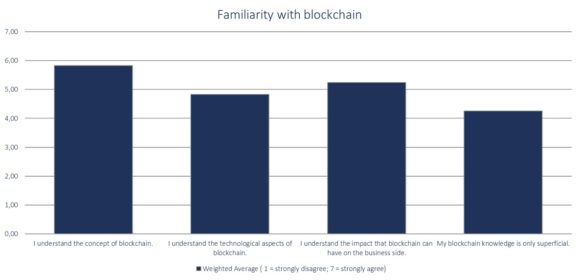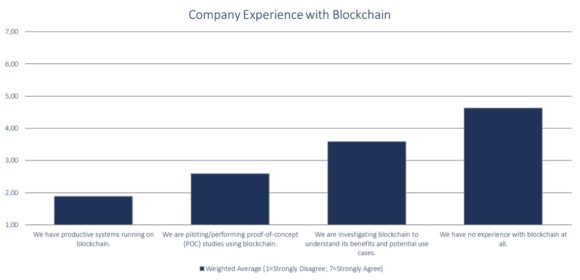Being one of the most promising technologies for information management, blockchain has been experiencing a conceptualization for a broad range of industries.
As an innovation leader, CAMELOT has readily anticipated the far-reaching implications for the healthcare industry with its complex structures. In a collaborative research project with the renowned University of Mannheim we investigated the following questions:
- Where do pharma companies stand with utilizing blockchain technology?
- What differentiates blockchain from current technologies?
- What are the challenges faced with blockchain adoption?
- What are prominent use cases within the healthcare industry?
Where do companies stand with utilizing blockchain technology?
By conducting interviews with industry experts in combination with a large-scale survey administered to key players of the healthcare industry, CAMELOT explored companies’ current level of blockchain maturity, their expectations, and current drawbacks associated with the technology. Most respondents claimed to have a solid personal knowledge of blockchain and a good understanding of its implications for the business side. However, the survey results also showed that most of the participating companies are still inexperienced with the technology.
What differentiates blockchain from current technologies?
Blockchain has some unique features that differentiate it from current technologies and enable companies to collaborate in entirely new ways. Especially trust is a topic that is most frequent-ly mentioned in the context of blockchain. One industry expert made the following statement when being asked if blockchain could make personal trust obsolete:
“Basically, yes. You still need to trust your business partners, but you don’t need to establish personal trust, that’s the difference and you also don’t need a third party to establish this trust. Basically, you can be sure that whenever everything goes through the blockchain, trust is there because blockchain provides that.”
Related to trust, is the topic of auditability and traceability which is an especially important one in the healthcare industry in terms of drug counterfeiting and legal compliance. Hereby, one of the business experts made the following statement:
“One aspect is the ownership of data. blockchain can officially prove which business partner was in possession of which information. This is currently not feasible. Being able to reliably identify the location of information, whether it was copied or not. In general, the auditability of data integrity is something that makes blockchain revolutionary. Thereby, blockchain does not simply improve an existing concept, but it delivers something entirely new.”
What are the challenges faced with blockchain adoption?
The fact that companies seem to be struggling with effectively exploring blockchain was also highlighted during the interviews. In this regard, one interview partner highlighted that most pharmaceutical companies are generally not yet digitalized and therefore lack the technologi-cal capabilities to effectively investigate blockchain. Further blockchain specific challenges are summarized below:
| CURRENT ISSUE | WHAT’S THE CHALLENGE? | HOW CAMELOT CAN HELP |
|---|---|---|
| Performance | • The original blockchain design has performance issues • Every transaction is duplicated locally for every participant • Additionally, the validation time per transaction is quite long |
• Camelot’s Hypertrust Network is compatible with private blockchains • Additionally, CAMELOT is extending blockchain cores with additional components like distributed filesystems and/or hybrid databases • In combination, this will solve the performance issues of public blockchains |
| User-friendliness | • Blockchain is currently very technological and confuses potential users • Companies have problems to comprehend blockchain technology |
• Hypertrust applies several functional layers on top of blockchain • The SAP UI5 User Interface makes it especially user-friendly • We provide educational services (e.g. Executive Briefing) |
| Onboarding of information | • Currently, it is difficult to guarantee the authenticity of data coming from outside into the blockchain | • We are using sophisticated IoT device-onboarding concepts to provide an appropriate level of authenticity of all blockchain writers |
| Data Privacy | • Companies do not want to disclose every single detail of a transaction • However, public blockchains do not allow to conceal parts of a transaction |
• We are developing solutions that process sensitive data in a private environment • At the same time these solutions seamlessly integrate with blockchains, building so called “Blockchain 3.0” systems which overcome the privacy issues of today’s blockchains |
What are prominent use cases within the healthcare industry?
The significance of traceability was emphasized by every interview partner. Especially the representatives of some of the major pharmaceutical companies highlighted the magnitude of loss in reputation and revenue they experience related to counterfeit drugs in developing countries. In addition to track and trace , two other promising use cases were discussed during the interviews. The three use cases are explained in detail below:
| USE CASE | HOW BLOCKCHAIN CAN HELP |
|---|---|
| Evaluation of business partners (suppliers) | • Suppliers’ past business activities are all transparently stored on a reputation sheet on-chain • All relevant information (payment practice, product quality, probability of machine breakdowns, etc.) is thereby visible • Companies will be able to select their business partners based on the reputation sheet as opposed to having to rely on trust • This allows to engage with partners in formerly inaccessible markets in which personal trust could not be established • Additionally, this improves the capabilities to more effectively monitor current suppliers |
| Supply chain track & trace | • Distributed ledger design enables information transparency and authenticity by onboarding all relevant parties across the entire supply chain • All relevant product information (price, date, location, quality, state of the product) will be stored (on- and off-chain) and immutably documented on the blockchain by hash registration. • The result is a complete, immutable end-to-end chain of transactions allowing to reliably track every drug back to the origin of its raw materials |
| Automated Contract Enforcement | • When two business partners establish a business relationship the terms of their contractual engagement are stored as a smart contract on the blockchain • In case of a simple supplier-manufacturer relationship, the smart contract automatically checks the agreed upon conditions when a product has been sent from the supplier to the manufacturer • If the transaction details (e.g., quality, delivery date, amount) match the contract requirements, the smart contract autono-mously initiates the corresponding payment process • The result is a highly optimized contract enforcement reducing the operating expenses of contract fulfillment |
In conclusion, blockchain in the healthcare sector is still evolving driven by high expectations and curiosity combined with uncertainty about how to realize the desired goals. Companies are highly aware of the benefits in terms of creating a personal-trust free environment characterized by high levels of information visibility and control. However, most of them lack the internal technological capabilities to fully exploit blockchain. Additionally, the technology itself is facing performance issues and needs to become more user-friendly.
CAMELOT understands companies’ needs and can provide them with the right use case combined with the required technological expertise to leverage blockchain for their success. A comprehensive use case portfolio as well as a detailed overview about the technology’s added value in the healthcare sector can be found here www.healthcare-blockchain.com.
Our affiliate Camelot ITLab has built its own blockchain network, called Camelot Hypertrust Platform, which provides its clients with a platform to leverage this new technology tailored towards their individual needs. Companies can use this platform to build respective digitalized applications on top of it, thereby taking theoretical use cases and turning them into reality.



